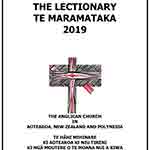
You will find New Zealand’s Lectionary Te Maramataka 2019 PDF online (1.72 MB – click link to download). Page numbers of the printed booklet are identical to the online version.
This post is just a collection of comments from a quick first glance. There is much in a publication such as this that is good and is of value, helping connect to the world-wide church, and back through the traditions of the centuries, while grounding us in this place in the South Pacific, at this time. Those tend to mostly be when the lectionary booklet expresses what we have agreed together – including celebrations of days that are international and ecumenical, as well as of persons who have expressed God’s love and life on these shores.
In a document like a lectionary, the devil, of course, is in the detail. That detail will, for some, appear as nitpicking (gnatpicking?). Pleasingly, some errors noted on this site in previous years have been corrected.
Page 5 includes a link to the online version of A New Zealand Prayer Book He Karakia Mihinare o Aotearoa. NB. if you are looking for the diglot material (English – Te Reo Maori) starting at page 476, that has been separated into two sections:
Te Whakawhetai me te Whakamoemiti
Thanksgiving and Praise
The trial collects have again been added in full in most places. This is an addition that will make this trial more widely known. Using any other collect continues to be allowed.
In 2019, ‘Propers’ have been removed. These were in previous Lectionaries without any explanation. Maybe reviews on this site are having an effect 🙂
But… the ‘Propers’ have only been removed prior to Lent! On page 77 we suddenly encounter Proper 7 without any explanation. Nor is there any indication what happened to the previous six Propers! [Proper numbering is what the Ordinary Sunday numbering would be if we followed our own agreement that Ordinary Time begins after the Presentation!]
Furthermore, on page 15, there are Propers I, II, and III (Roman numerals) followed immediately by Propers 1, 2, and 3 (Arabic numerals). And the instructions around their use contradict each other (can “Proper II and the collect, Proper 2, be used for Midnight or only on ‘Christmas Day’?)
Some errors have not been corrected. General Synod Te Hinota Whanui (GSTHW) went to significant effort (starting five years ago and debated in every diocesan synod and hui amorangi, then debated again at the next meeting of General Synod Te Hinota Whanui) about the use of “of, in, or after” in titles for Sundays. The agreement was Sundays “of Epiphany” – yet the Lectionary calls them Sundays “of the Epiphany”. This error was pointed out three years running now.
Our church’s formulary (agreement) is that “Ordinary time is the period after the Feast of the Presentation of Christ” (February 2). Yet the first Sunday after The Presentation (February 3), rather than being called the “1st Sunday in Ordinary Time” (following our GSTHW ruling) is called the “4th Sunday in Ordinary Time”. There is no sign of the 3rd or earlier Sundays in Ordinary Time. [My own solution to this would be to change the formulary, and have our Ordinary Time begin the day after the Feast of the Baptism of the Lord following majority Christianity and the originators of the concept].
The 5th Sunday in Lent (April 7) is optionally called “Passion Sunday” while there is no mention of the Passion. Ecumenical, international reform has the reading of the Passion on the 6th Sunday in Lent (as our Lectionary does also). The title “Passion Sunday” is, hence, best reserved for that international, ecumenical agreement.
“after” was not an option agreed to by GSTHW but “Sunday after Ascension” is an option in the Lectionary for 2 June.
On page 44 begins readings for “the 3rd Week of Lent”. Should that be “in Lent”? Furthermore, these readings are said to originate in “CWL” – there is no indication what CWL stands for or its status in our church or why there are not similar readings provided for the 1st and 2nd weeks “of Lent”.
As in previous years, I would be interested to know where this lectionary booklet gets the ruling from: “The reading from Acts must be used each Sunday in Eastertide” (pages 56ff). It may very well be a good idea – but where does “must” come from? We are only required to follow formularies of our church – not what is indicated by this lectionary booklet. This is an important principle. Where the lectionary booklet does not conform to the formularies, we must follow the formularies, not the lectionary booklet. Where the lectionary booklet sets requirements beyond what the formularies require, we do not need to follow the booklet.
[Furthermore, as an aside, where does “Eastertide” come from in this lectionary booklet? Our formularies consistently call this “The Season of Easter”.]
Each year, I have been noting our Anglican Church of Or suggestion to have all four colours in the lectionary for the Second Sunday in November (10 November). The colours in the lectionary booklet are not required to be followed – in fact, the lectionary booklet itself claims it is simply collating “common practice in most parishes” page 4.
Other issues of the Anglican Church of Or continue.
November 24 can be:
Christ the King Sunday
or The Reign of Christ Sunday
or 34th Sunday in Ordinary Time
or Sunday before Advent
or Aotearoa Sunday
or Feast of Christ in All Creation
or, of course, A Spring Festival of Praise to the Creator (see page 141).
Are there any things you notice as you skim through the lectionary booklet for 2019 – things you like; things you think can be improved?
If you appreciated this post, consider liking the liturgy facebook page, using the RSS feed, and/or signing up for a not-very-often email, …



